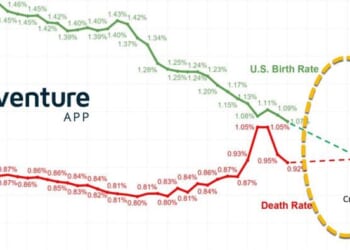Via Brian McGlinchey at Stark Realities
Chances are, you’re already aware that birthrates are falling throughout the developed world, sagging well below the “replacement rate” and sparking worries about the implications of a future dearth of workers and consumers. However, the emphasis on economic implications has allowed a powerful political undercurrent to go almost entirely unnoticed: Birthrates are varying significantly by political orientation, a trend that has the potential to shape electorates and policies for generations to come — to the benefit of conservatives.
Replacement birthrates vary over time and place depending on shifts in related variables such as child mortality. In developed countries, sustaining populations without immigration currently requires reproduction at a rate of 2.1 births per woman of childbearing age. Except for an outlier replacement-level pace in 2007, the US birthrate has been sub-2.1 since the early 1970s. Last year, America hit a record-low 1.6, with even lower lows recorded elsewhere in the developed world: the birth rate in England and Wales fell to 1.41, while Scotland’s dropped to 1.25 and Italy’s to 1.2. Mainland France’s 1.59 was the lowest since World War I.
Media coverage has uniformly emphasized those top-line numbers. However, Financial Times columnist and chief data reporter John Burn-Murdoch recently waded deeper into the data and illuminated a sub-trend that could shape the future of the West. It turns out the drop-off in top-line birthrates is primarily the result of plummeting parenthood among progressive leftists, with conservative fertility slipping to a far smaller degree.
“From the US to Europe and beyond, people who identify as conservative are having almost as many children as they were decades ago,” Burn-Murdoch wrote. “The decline is overwhelmingly among those on the progressive left, in effect nudging each successive generation’s politics further to the right than they would otherwise have been.”

Readers might reasonably wonder if the birthrate numbers merely reflect the fact that people tend to become more conservative upon having children — particularly on social issues. That’s not the case. Critically, even aspirations to have children vary widely by political orientation. Illustrating the extremes on the continuum, a September NBC News poll found that male, Gen Z Trump voters put “having children” high atop their list of what’s central to their “personal definition of success.” In stark contrast, female Gen Z Kamala Harris voters put raising children in 12th place out of the 13 life goals presented as options, below aspirations like “having a job or career you find fulfilling” (which came in first) and “having emotional stability” (which placed third).
The conservative fertility edge shows up in state-level data. The 10 states with the highest 2023 birthrates were all Republican-majority states, led by South Dakota (2.01), Nebraska (1.92) and North Dakota (1.85). The bottom 10 were all “blue” states, with Vermont (1.30) at the bottom, and Oregon, Massachusetts, California, Washington and Illinois among those in the bottom pack. Paired with the trend of people migrating from blue states, it’s safe to say their lagging birthrates assure continued shrinkage in their congressional delegations, electoral votes and political power.
Looking more broadly, conservatives already have a population edge in America, with 33% of adults saying they’re conservative or very conservative, compared to just 24% who identify as liberal or very liberal. Self-categorized moderates represent a plurality, at 38%.
As your own extended family tree likely demonstrates, parents’ political leanings don’t strictly determine the views of their offspring. However, while most parents say they don’t make indoctrination a priority, their leanings do have an outsize influence in the grand scheme.
A 2023 Pew Research analysis found that only 16% of parents said it was extremely or very important for their children to grow up to hold political views similar to their own. Despite that, 81% of Republicans’ teenage children identify as either Republican or leaning toward the GOP; the Democratic correlation is 89%. Even if we assume that correlation decreases somewhat after the teen years, the large birthrate gap between conservatives and progressives promises to give the West’s politics a clear shove to the right over the coming decades.
Join thousands of free Stark Realities subscribers
Will immigration weaken that shove? Conservatives have long been wary of the political implications of large immigrant inflows, accusing Democrats of promoting lax border policies in a self-serving scheme to import Democratic voters. Bolstering that case, a 2023 Kaiser Family Foundation survey found that 32% of foreign-born people living in the US prefer the Democratic Party, with only half that number — 16% — saying the Republican Party best represents their views. A hefty 52% preferred “neither party” or were “not sure.”
Importantly, an immigration sea change is underway. At least for the time being, migrant inflows have not only come to a screeching halt, but have even reversed. In January, there were 53.3 million foreign-born immigrants in the country. Six months later, those ranks had fallen by more than a million, the first such decline since the 1960s. Having peaked at 15.8% of the US population, foreign-born people now account for 15.4%.
In what could be a self-reinforcing dynamic, a rightward shift driven by conservatives’ higher fertility could help perpetuate policies that tamp down immigration, further shifting the math in favor of the right. We’ve already seen a major sentiment shift, as Americans attitudes about immigration soured mightily during the Biden presidency: The percent wanting fewer immigrants soared from 28% in 2000 to 55% in 2024, according to Gallup. (The percent dropped way back to 30% this summer, but with dramatically tighter immigration policies resulting in net emigration for the first time in well over 50 years, that particular finding seems like something of an apples vs oranges comparison.)

With European populations displaying their own rising impatience with the effects of mass immigration — a dynamic that has translated into a significant tightening of policies across the continent — immigration doesn’t seem poised to fully offset conservatives’ higher fertility either in Europe or the United States, at least for now.
Many factors are driving declining birthrates in the progressive left, including a lower level of enthusiasm — and often, outright disdain — for traditional family structures, greater prioritization of women’s career success, and a fatalism that makes the gift of life seem like a mixed proposition at best.
The Times’ Burn-Murdoch also points a finger at progressives who’ve convinced themselves that bringing new humans into the world will accelerate climate change. However, he notes that any given country’s level of carbon emissions is overwhelmingly driven by technology, not population, as evidenced by plummeting carbon emissions throughout the developed world even as their populations have continued to rise.

Even among progressives who do aspire to reproduce, there seem to be other self-defeating dynamics at work. For example, in their rebellion against traditional norms and expectations, and their desire to signal their subcultural alignment, progressives are more likely to make personal-appearance choices that could undermine their ability to land a mate.
Purple hair with an unconventional cut may be boldly expressive, but it comes at some unquantifiable price in the dating marketplace. The steepest price probably comes from septum-piercing — nose-rings that stray far from adornment and into outright self-vandalism. Science backs the idea that such piercings are bad for one’s love life: A study published by European Psychologist found that both women and men with facial piercings were perceived as not only less physically attractive but also less intelligent.
This TikToker took off her nose ring for the first time in a long time and immediately realized men are right.
“Someone said I look like a Democrat cause of the nose ring, so I’m taking it out.”
Nose rings and tattoos are some of the worst things women ever got into. pic.twitter.com/oF0zmwtTHr
— George (@BehizyTweets) October 22, 2025
That’s not all. Leftists are also far more likely to limit their dating pool by excluding people with differing political views: Among self-identified “very liberal” people, only 13% are willing to date conservatives. Putting that into perspective, 29% of them are willing to date an ex-felon. On the other hand, very conservative Americans are nearly twice as willing to date their political opposites.
When looking to the political future, it’s often said that “demographics are destiny.” For the most part, progressives have employed the axiom with a swaggering confidence in their inevitable triumph, while conservatives have used it with a tone of grim resignation. Given the reproductive realities, we may soon see a rhetorical role reversal.
STARK REALITIES: Invigoratingly Unorthodox Perspectives For Intellectually Honest Readers
Sign up and join thousands of free subscribers who benefit from monthly, ad-free insights
* * *
Views expressed in this article are opinions of the author and do not necessarily reflect the views of ZeroHedge
Loading recommendations…



















